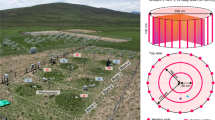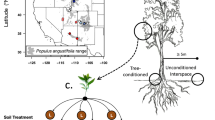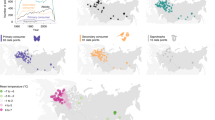Abstract
Anthropogenic climate warming is altering phenology—the biological timing of life-cycle events—across trophic levels worldwide. However, it remains unclear whether warming induces differential changes in phenology between plants and soil microorganisms—two fundamental components of terrestrial biodiversity and food chains. Here we report a consistent mismatch between plant and soil microbial phenology under climate warming, on the basis of 1,032 globally distributed observations of phenological shifts in plant and/or soil microbial respiration in response to experimental warming. Advances in spring phenology and delays in autumn phenology are greater in soil microorganisms than in both plant shoots and roots, particularly under tall vegetation (for example, forests) compared with low vegetation (for example, grasslands). Furthermore, phenology shifts in soil microorganisms are greater in soils with high carbon-to-nitrogen ratios, such as those in boreal regions, than in those with lower ratios. Such phenological mismatches between plants and soil microorganisms could destabilize their temporal synchrony, decoupling above- and belowground processes, and ultimately degrading energy flow and ecosystem functioning under climate warming.
This is a preview of subscription content, access via your institution
Access options
Access Nature and 54 other Nature Portfolio journals
Get Nature+, our best-value online-access subscription
$32.99 / 30 days
cancel any time
Subscribe to this journal
Receive 12 print issues and online access
$259.00 per year
only $21.58 per issue
Buy this article
- Purchase on SpringerLink
- Instant access to full article PDF
Prices may be subject to local taxes which are calculated during checkout




Similar content being viewed by others
Data availability
Data for the meta-analysis in this research are available in the figshare repository (https://doi.org/10.6084/m9.figshare.26317330). Climate data were obtained from WorldClim v.2.0 (http://www.worldclim.org/), soil moisture data from ESA CCI v.07.1 (https://www.esa-soilmoisture-cci.org/), other soil properties and leaf area index data from the Global Soil Dataset for Earth System Models (http://globalchange.bnu.edu.cn/) and canopy height data used for vegetation type classification from the Global 1 km Forest Canopy Height dataset (https://webmap.ornl.gov/wcsdown/dataset.jsp?ds_id=10023). Source data are provided with this paper.
Code availability
Codes for analysis will be accessible in the figshare repository (https://doi.org/10.6084/m9.figshare.26317330).
References
Piao, S. et al. Plant phenology and global climate change: current progresses and challenges. Glob. Chang. Biol. 25, 1922–1940 (2019).
Albert, L. P. et al. Cryptic phenology in plants: case studies, implications, and recommendations. Glob. Chang. Biol. 25, 3591–3608 (2019).
Thackeray, S. J. et al. Phenological sensitivity to climate across taxa and trophic levels. Nature 535, 241–245 (2016).
Burgess, M. D. et al. Tritrophic phenological match–mismatch in space and time. Nat. Ecol. Evol. 2, 970–975 (2018).
Yin, R. et al. Experimental warming causes mismatches in alpine plant–microbe–fauna phenology. Nat. Commun. 14, 2159 (2023).
Beard, K. H., Kelsey, K. C., Leffler, A. J. & Welker, J. M. The missing angle: ecosystem consequences of phenological mismatch. Trends Ecol. Evol. 34, 885–888 (2019).
Visser, M. E. & Gienapp, P. Evolutionary and demographic consequences of phenological mismatches. Nat. Ecol. Evol. 3, 879–885 (2019).
Renner, S. S. & Zohner, C. M. Climate change and phenological mismatch in trophic interactions among plants, insects, and vertebrates. Annu. Rev. Ecol. Evol. Syst. 49, 165–182 (2018).
Rudgers, J. A. et al. Climate disruption of plant–microbe interactions. Annu. Rev. Ecol. Evol. Syst. 51, 561–586 (2020).
Wardle, D. A. et al. Ecological linkages between aboveground and belowground biota. Science 304, 1629–1633 (2004).
Van der Putten, W. H., Vet, L. E. M., Harvey, J. A. & Wäckers, F. L. Linking above- and belowground multitrophic interactions of plants, herbivores, pathogens, and their antagonists. Trends Ecol. Evol. 16, 547–554 (2001).
Kuzyakov, Y. & Xu, X. Competition between roots and microorganisms for nitrogen: mechanisms and ecological relevance. New Phytol. 198, 656–669 (2013).
Frantzeskakis, L. et al. Rapid evolution in plant–microbe interactions—a molecular genomics perspective. New Phytol. 225, 1134–1142 (2020).
Körner, C. & Basler, D. Phenology under global warming. Science 327, 1461–1462 (2010).
Liu, Q. et al. Temperature, precipitation, and insolation effects on autumn vegetation phenology in temperate China. Glob. Chang. Biol. 22, 644–655 (2016).
Bonato Asato, A. E., Wirth, C., Eisenhauer, N. & Hines, J. On the phenology of soil organisms: current knowledge and future steps. Ecol. Evol. 13, e10022 (2023).
Sáez-Sandino, T. et al. The soil microbiome governs the response of microbial respiration to warming across the globe. Nat. Clim. Change 13, 1382–1387 (2023).
Steinaker, D. F., Wilson, S. D. & Peltzer, D. A. Asynchronicity in root and shoot phenology in grasses and woody plants. Glob. Chang. Biol. 16, 2241–2251 (2010).
Davidson, E. A. & Janssens, I. A. Temperature sensitivity of soil carbon decomposition and feedbacks to climate change. Nature 440, 165–173 (2006).
Luo, Y., Wan, S., Hui, D. & Wallace, L. L. Acclimatization of soil respiration to warming in a tall grass prairie. Nature 413, 622–625 (2001).
Trumbore, S. Carbon respired by terrestrial ecosystems—recent progress and challenges. Glob. Chang. Biol. 12, 141–153 (2006).
Liu, H. et al. Phenological mismatches between above- and belowground plant responses to climate warming. Nat. Clim. Change 12, 97–102 (2022).
Richardson, A. D. et al. Influence of spring and autumn phenological transitions on forest ecosystem productivity. Philos. Trans. R. Soc. B 365, 3227–3246 (2010).
Osburn, E. D., Yang, G., Rillig, M. C. & Strickland, M. S. Evaluating the role of bacterial diversity in supporting soil ecosystem functions under anthropogenic stress. ISME Commun. 3, 66 (2023).
Ochoa-Hueso, R. et al. Ecosystem coupling: a unifying framework to understand the functioning and recovery of ecosystems. One Earth 4, 951–966 (2021).
Thakur, M. P., Risch, A. C. & van der Putten, W. H. Biotic responses to climate extremes in terrestrial ecosystems. iScience 25, 104559 (2022).
Atkin, O. K. & Tjoelker, M. G. Thermal acclimation and the dynamic response of plant respiration to temperature. Trends Plant Sci. 8, 343–351 (2003).
Fu, Y. H. et al. Declining global warming effects on the phenology of spring leaf unfolding. Nature 526, 104–107 (2015).
Zani, D., Crowther, T. W., Mo, L., Renner, S. S. & Zohner, C. M. Increased growing-season productivity drives earlier autumn leaf senescence in temperate trees. Science 370, 1066–1071 (2020).
Zohner, C. M. et al. Effect of climate warming on the timing of autumn leaf senescence reverses after the summer solstice. Science 381, eadf5098 (2023).
Najar, A., Landhäusser, S. M., Whitehill, J. G. A., Bonello, P. & Erbilgin, N. Reserves accumulated in non-photosynthetic organs during the previous growing season drive plant defenses and growth in aspen in the subsequent growing season. J. Chem. Ecol. 40, 21–30 (2014).
Radville, L., McCormack, M. L., Post, E. & Eissenstat, D. M. Root phenology in a changing climate. J. Exp. Bot. 67, 3617–3628 (2016).
Gallinat, A. S., Primack, R. B. & Wagner, D. L. Autumn, the neglected season in climate change research. Trends Ecol. Evol. 30, 169–176 (2015).
Wang, H. et al. Alpine grassland plants grow earlier and faster but biomass remains unchanged over 35 years of climate change. Ecol. Lett. 23, 701–710 (2020).
Brown, J. H., Gillooly, J. F., Allen, A. P., Savage, V. M. & West, G. B. Toward a metabolic theory of ecology. Ecology 85, 1771–1789 (2004).
Chen, R. et al. Soil C and N availability determine the priming effect: microbial N mining and stoichiometric decomposition theories. Glob. Chang. Biol. 20, 2356–2367 (2014).
Moorhead, D. L. & Sinsabaugh, R. L. A theoretical model of litter decay and microbial interaction. Ecol. Monogr. 76, 151–174 (2006).
Prevéy, J. et al. Greater temperature sensitivity of plant phenology at colder sites: implications for convergence across northern latitudes. Glob. Chang. Biol. 23, 2660–2671 (2017).
Karhu, K. et al. Temperature sensitivity of soil respiration rates enhanced by microbial community response. Nature 513, 81–84 (2014).
Garcia, F. C. et al. The temperature dependence of microbial community respiration is amplified by changes in species interactions. Nat. Microbiol. 8, 272–283 (2023).
Hodge, A., Robinson, D. & Fitter, A. Are microorganisms more effective than plants at competing for nitrogen? Trends Plant Sci. 5, 304–308 (2000).
Wang, X. et al. Soil respiration under climate warming: differential response of heterotrophic and autotrophic respiration. Glob. Chang. Biol. 20, 3229–3237 (2014).
De Frenne, P. et al. Forest microclimates and climate change: importance, drivers and future research agenda. Glob. Chang. Biol. 27, 2279–2297 (2021).
Lu, C. et al. Diminishing warming effects on plant phenology over time. New Phytol. 245, 523–533 (2025).
Steinaker, D. F. & Wilson, S. D. Phenology of fine roots and leaves in forest and grassland. J. Ecol. 96, 1222–1229 (2008).
Hicks Pries, C. E., Castanha, C., Porras, R. C. & Torn, M. S. The whole-soil carbon flux in response to warming. Science 355, 1420–1423 (2017).
Bond-Lamberty, B., Bronson, D., Bladyka, E. & Gower, S. T. A comparison of trenched plot techniques for partitioning soil respiration. Soil Biol. Biochem. 43, 2108–2114 (2011).
IPCC Climate Change 2021: The Physical Science Basis (eds Masson-Delmotte, V. et al.) 3–32 (Cambridge Univ. Press, 2021).
Miki, T., Ushio, M., Fukui, S. & Kondoh, M. Functional diversity of microbial decomposers facilitates plant coexistence in a plant–microbe–soil feedback model. Proc. Natl Acad. Sci. USA 107, 14251–14256 (2010).
Kharouba, H. M. & Wolkovich, E. M. Disconnects between ecological theory and data in phenological mismatch research. Nat. Clim. Change 10, 406–415 (2020).
Bastida, F. et al. Soil microbial diversity–biomass relationships are driven by soil carbon content across global biomes. ISME J. 15, 2081–2091 (2021).
Fan, Y., Miguez-Macho, G., Jobbágy, E. G., Jackson, R. B. & Otero-Casal, C. Hydrologic regulation of plant rooting depth. Proc. Natl Acad. Sci. USA 114, 10572–10577 (2017).
Beck, H. E. et al. Present and future Köppen–Geiger climate classification maps at 1-km resolution. Sci. Data 5, 180214 (2018).
Wood, S. N. P-splines with derivative based penalties and tensor product smoothing of unevenly distributed data. Stat. Comput. 27, 985–989 (2017).
Denuit, M., Hainaut, D. & Trufin, J. in Effective Statistical Learning Methods for Actuaries I (eds Denuit, M. et al.) 253–327 (Springer, 2019).
Buitenwerf, R., Rose, L. & Higgins, S. I. Three decades of multi-dimensional change in global leaf phenology. Nat. Clim. Change 5, 364–368 (2015).
Walker, T. W. N. et al. A systemic overreaction to years versus decades of warming in a subarctic grassland ecosystem. Nat. Ecol. Evol. 4, 101–108 (2019).
Nottingham, A. T., Meir, P., Velasquez, E. & Turner, B. L. Soil carbon loss by experimental warming in a tropical forest. Nature 584, 234–237 (2020).
Liu, H. et al. Shifting plant species composition in response to climate change stabilizes grassland primary production. Proc. Natl Acad. Sci. USA 115, 4051–4056 (2018).
Melillo, J. M. et al. Long-term pattern and magnitude of soil carbon feedback to the climate system in a warming world. Science 358, 101–104 (2017).
Adams, D. C., Gurevitch, J. & Rosenberg, M. S. Resampling tests for meta-analysis of ecological data. Ecology 78, 1277–1283 (1997).
Egger, M., Smith, G. D., Schneider, M. & Minder, C. Bias in meta-analysis detected by a simple, graphical test. BMJ 315, 629–634 (1997).
LeDell, E. & Poirier, S. H2O AutoML: scalable automatic machine learning. In Proc. 7th ICML Workshop on Automated Machine Learning 1–16 (ICML, 2020).
R Core Team R: A Language and Environment for Statistical Computing (R Foundation for Statistical Computing, 2025).
Wang, H. et al. Dataset and R code for ‘Divergent phenological responses of soil microorganisms and plants to climate warming’. figshare https://doi.org/10.6084/m9.figshare.26317330 (2025).
Acknowledgements
This research was financially sponsored by the National Natural Science Foundation of China (grants 32422058 (H.W.), 32130065 (J.-S.H.), 32371618 (H.W.)), National Key Research and Development Program of China (grant 2023YFF0806800 (H.L.)) and Gansu Provincial Science and Technology Major Projects (grant 23ZDNA009 (H.W.)). M.P.T acknowledges funding from the Swiss State Secretariat for Education, Research and Innovation (SERI) under contract M822.0029.
Author information
Authors and Affiliations
Contributions
H.W. designed the research with inputs from M.P.T., J.-S. H. and H.L. H.Z., C.L., Y.H. and J.Z. compiled and analysed the data. H.W., H.Z., H.L., C.L. and M.P.T. wrote the paper.
Corresponding authors
Ethics declarations
Competing interests
The authors declare no competing interests.
Peer review
Peer review information
Nature Geoscience thanks Ana Asato, Gesche Blume-Werry and Nicolas Delpierre for their contribution to the peer review of this work. Primary Handling Editors: Xujia Jiang and Stefan Lachowycz, in collaboration with the Nature Geoscience team.
Additional information
Publisher’s note Springer Nature remains neutral with regard to jurisdictional claims in published maps and institutional affiliations.
Extended data
Extended Data Fig. 1 Phenological shifts of plant and soil microbial respiration in response to warming from studies with at least seven months of annual observations.
a, Ecosystem respiration, Re. b, Soil respiration, Rs. c, Soil microbial respiration, Rm. d, Plant root respiration, Rr. e, Plant aboveground respiration, Ra. The first row displays the components of each respiration metric (plant aboveground parts, roots and/or soil microorganisms, highlighted in bright colors), along with its respective observation count. The second row shows phenological shifts, while the third row displays phenological sensitivities to warming. Results are based on the absolute threshold approach. Points with error bars represent weighted means with 95% confidence intervals. Statistical significance (P < 0.05) for each phenological stage was tested using two-sided t-tests from linear mixed-effects models without multiple comparison correction.
Extended Data Fig. 2 Phenological shifts of soil microbial and plant root respiration in response to warming, based on studies that partitioned soil microbial (Rm) and root respiration (Rr).
a, Phenological shift of Rm. b, Phenological shift of Rr. c, Phenological sensitivity of Rm. d, Phenological sensitivity of Rr. Results are based on the absolute threshold approach. Points with error bars represent weighted means with 95% confidence intervals. Statistical significance (P < 0.05) for each phenological stage was tested using two-sided t-tests from linear mixed-effects models without multiple comparison correction.
Extended Data Fig. 3 Phenological sensitivity of plant and soil microbial respiration to warming, based on different phenological extraction approaches.
a, Ecosystem respiration, Re. b, Soil respiration, Rs. c, Soil microbial respiration, Rm. d, Plant root respiration, Rr. e, Plant aboveground respiration, Ra. The first row displays the components of each respiration metric (plant aboveground parts, roots and/or soil microorganisms, highlighted in bright colors), along with its respective observation count. The second and third rows depict phenological sensitivity to warming for each phenological stage, calculated using the absolute and dynamic threshold approaches, respectively. Potential outliers in phenological sensitivity (exceeding 15 days per degree of warming, based on the reported global range in Thackeray et al. (2016, ref. 3)) are removed in this analysis. Points with error bars represent weighted means with 95% confidence intervals. Statistical significance (P < 0.05) for each phenological stage was tested using two-sided t-tests from linear mixed-effects models without multiple comparison correction.
Extended Data Fig. 4 Influence of vegetation types on the phenological responses of soil microbial and plant root respiration to warming, based on studies that partitioned soil microbial (Rm) and root respiration (Rr).
a-b, Phenological shift (a) and sensitivity (b) under different vegetation types (tall vegetation and low vegetation). Results are based on the absolute threshold approach. Points with error bars represent weighted means with 95% confidence intervals. Statistical significance (P < 0.05) for each phenological stage was tested using two-sided t-tests from linear mixed-effects models without multiple comparison correction.
Extended Data Fig. 5 Influence of experimental warming and respiration partitioning methods on the phenological responses of soil microbial and plant root respiration to warming, based on studies that partitioned soil microbial (Rm) and root respiration (Rr).
a-b, Phenological shift (a) and sensitivity (b) under different warming methods (chamber, infrared heater, and heating cable). c-d, Phenological shift (c) and sensitivity (d) under different partitioning methods (trench and exclusion collars). Results are based on the absolute threshold approach. Points with error bars represent weighted means with 95% confidence intervals. Statistical significance (P < 0.05) for each phenological stage was tested using two-sided t-tests from linear mixed-effects models without multiple comparison correction.
Extended Data Fig. 6 Phenological sensitivity of soil microbial (Rm) and plant root respiration (Rr) to warming in the Northern Hemisphere (20°–90°N) and associated prediction uncertainty, evaluated by standard deviation (SD).
a, Phenological sensitivity of Rm. b, Phenological sensitivity of Rr. c, SD of phenological sensitivity of Rm. d, SD of phenological sensitivity of Rr. Phenological sensitivity is predicted using AutoML, averaged over five runs, while SD is derived from predictions across these runs. In (a-b), R2 indicates model performance based on the relationship between measured phenological sensitivities and predicted values. Numbers in brackets at the top show the percentage of pixels with advanced phenology (left) and delayed phenology (right). Comparisons are made between temperate (Tem., 2 °C ≤ Mean annual temperature ≤ 17 °C) and boreal regions (Bor., Mean annual temperature < 2 °C). Double asterisks (**) indicate statistically significant differences (P < 0.01).
Supplementary information
Supplementary Information
Supplementary Tables 2 and 3 and Figs. 1–7.
Supplementary Table 1
Summary of warming studies included in this meta-analysis.
Supplementary Dataset
Source data for Supplementary Figs. 1 and 4–7.
Source data
Source Data Fig. 1
Source data for Fig. 1a.
Source Data Fig. 2
Source data for Fig. 2.
Source Data Fig. 3
Source data for Fig. 3.
Source Data Fig. 4
Source data for Fig. 4.
Source Data Extended Data Fig. 1
Source data for Extended Data Fig. 1.
Source Data Extended Data Fig. 2
Source data for Extended Data Fig. 2.
Source Data Extended Data Fig. 3
Source data for Extended Data Fig. 3.
Source Data Extended Data Fig. 4
Source data for Extended Data Fig. 4.
Source Data Extended Data Fig. 5
Source data for Extended Data Fig. 5.
Source Data Extended Data Fig. 6
Source data for Extended Data Fig. 6.
Rights and permissions
Springer Nature or its licensor (e.g. a society or other partner) holds exclusive rights to this article under a publishing agreement with the author(s) or other rightsholder(s); author self-archiving of the accepted manuscript version of this article is solely governed by the terms of such publishing agreement and applicable law.
About this article
Cite this article
Wang, H., Zhou, H., He, JS. et al. Divergent phenological responses of soil microorganisms and plants to climate warming. Nat. Geosci. 18, 753–760 (2025). https://doi.org/10.1038/s41561-025-01738-9
Received:
Accepted:
Published:
Issue date:
DOI: https://doi.org/10.1038/s41561-025-01738-9



